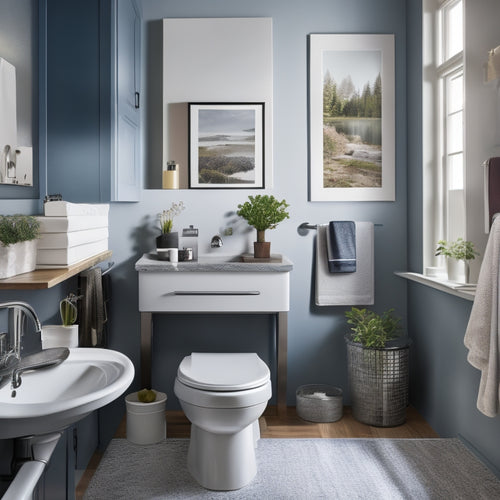
Patent Eligibility Criteria Unveiled: A Comprehensive Guide
Share
The United States patent system establishes clear eligibility criteria, dividing patentable subject matter into four statutory categories: processes, machines, manufactures, and compositions of matter. Claims must integrate judicial exceptions, such as abstract ideas, laws of nature, and natural phenomena, into practical applications to qualify for protection. The Alice/Mayo test framework is used to determine patent eligibility, evaluating if a claim is directed to a judicial exception and provides an inventive concept. By understanding these guidelines, inventors and examiners can navigate the complex patent system, and a closer examination of these principles reveals the intricacies of patent eligibility.
Key Takeaways
• Patent eligibility requires claims to fall within statutory categories: processes, machines, manufactures, or compositions of matter.
• Claims directed to abstract ideas, laws of nature, or natural phenomena are judicial exceptions and must be integrated into practical applications.
• The Alice/Mayo test is a two-part framework for patent eligibility, evaluating if a claim is directed to a judicial exception and provides an inventive concept.
• Examiners follow structured pathways (A, B, and C) for claim evaluation, considering claim interpretation, categorization, and the presence of an inventive concept.
• Thorough evaluation of claim eligibility involves considering multiple factors, including claim interpretation, categorization, and practical applications.
Understanding Statutory Categories
The US patent system recognizes four statutory categories - processes, machines, manufactures, and compositions of matter - as the foundation for patent subject matter eligibility. Understanding patentable subject matter begins with grasping the nuances of these categories.
Processes involve actions or steps to produce specific outcomes, while machines consist of tangible devices performing functions through mechanical powers. Manufactures are tangible articles with new forms or properties, and compositions of matter encompass combinations of substances, including genetically modified organisms.
It's essential to recognize that claims must fall within one of these categories to be considered patent-eligible. By understanding the statutory category nuances, inventors and patent attorneys can navigate the patent eligibility landscape with confidence, ensuring their claims meet the necessary criteria.
Judicial Exceptions and Limitations
Claims that fall under judicial exceptions, including abstract ideas, laws of nature, and natural phenomena, aren't patent-eligible unless they're integrated into practical applications with additional limitations. These exceptions aren't eligible for patent protection in their isolated form, as they're considered fundamental principles or building blocks of nature and human knowledge.
However, when integrated into practical applications, they can become patent-eligible. For instance, an abstract idea, such as a mathematical formula, can be patented when applied to a specific industry or technical field. The integration of judicial exceptions into practical applications guarantees that patent protection is granted only for innovative and useful applications, rather than mere concepts or principles.
The Alice/Mayo Test Framework
To determine whether a claim is patent-eligible, examiners apply the Alice/Mayo test, a two-part framework that distinguishes between abstract ideas and patent-eligible applications.
This test assesses whether the claim is directed to a judicial exception, such as an abstract idea, and if so, whether it provides an inventive concept. Claim interpretation plays an important role in both parts of the test, as it influences the determination of whether the claim is directed to an exception and whether additional elements provide a meaningful limitation.
The Alice/Mayo test seeks to determine if the claim recites elements substantially more than the judicial exception. By applying this framework, examiners can identify claims that integrate judicial exceptions into practical applications, thereby rendering them patent-eligible due to the presence of inventive concepts.
Evaluating Claim Eligibility Pathways
Examiners employ a structured approach, following a flowchart to navigate three distinct pathways (A, B, and C) when evaluating claim eligibility, thereby ensuring a thorough and systematic assessment of patent eligibility criteria.
Pathway A involves claims within statutory categories with self-evident eligibility, while Pathway B includes claims within statutory categories not directed to judicial exceptions.
In Pathway C, examiners apply the Alice/Mayo test to determine if claims recite an inventive concept. Claim interpretation plays an essential role in this evaluation, as it defines the scope of the claim and influences the determination of patent eligibility.
The examiners carefully consider the claim elements to identify any inventive concept, ensuring that the claim isn't directed to an abstract idea or judicial exception.
Patent Eligibility Analysis Factors
During the patent eligibility analysis, several important factors are carefully considered to determine whether an invention meets the statutory requirements. These factors include claim interpretation, which plays a critical role in evaluating patent eligibility, and claim categorization, which involves determining whether a claim falls within a statutory category.
Additionally, the analysis considers the presence of an inventive concept and whether the claim is directed to practical applications.
To guarantee patent eligibility, examiners meticulously evaluate these factors:
-
Claim interpretation and its impact on patent eligibility
-
The presence of an inventive concept that integrates a judicial exception
-
The claim's direction towards practical applications that demonstrate patent eligibility
Examiner's Role in Claim Categorization
As an essential step in determining patent eligibility, claim categorization relies heavily on the examiner's expertise in accurately identifying whether a claim falls within one of the four statutory categories. The examiner's role is vital in ensuring that claims are properly categorized, as this directly impacts patent eligibility. Examiner guidance is essential in providing clear and concise explanations for claim categorization, facilitating effective claim interpretation.
| Examiner's Role | Claim Categorization | Patent Eligibility |
|---|---|---|
| Accurate identification | Statutory categories | Processes, machines, manufactures, compositions of matter |
| Clear guidance | Claim interpretation | Abstract ideas, laws of nature, natural phenomena |
| Effective communication | Claim amendments | Integration into practical applications |
| Expertise in categorization | Claim narrowing | Meeting patent eligibility requirements |
| Essential in patent eligibility | Proper categorization | Ensuring patent eligibility |
Meeting Patent Eligibility Requirements
Claims must satisfy the patent eligibility criteria by falling within one of the four statutory categories and integrating judicial exceptions into practical applications to meet the patent eligibility requirements. This integration is important, as it distinguishes between patent-eligible applications and judicial exceptions.
To guarantee patent eligibility, inventors should consider the following key aspects:
-
Claim interpretation: Accurate interpretation of claims is essential to determine if they fall within statutory categories and integrate judicial exceptions.
-
Integration determination: The machine-or-transformation test is a critical part of the integration determination, ensuring that claims reciting judicial exceptions are integrated into practical applications.
-
Practical application: Claims must be directed to practical applications that provide a tangible outcome, rather than abstract ideas or natural phenomena.
Frequently Asked Questions
Can Patent Eligibility Be Re-Evaluated During the Appeal Process?
She can re-evaluate patent eligibility during the appeal process, adopting an appeal strategy that refines claims and presents new arguments, initiating a re-evaluation process that may reverse examiner decisions and secure patent protection.
How Do Patent Laws Vary Across Different Countries?
She notes that patent laws vary across countries due to regional differences, despite efforts towards international harmonization, resulting in distinct patentability criteria, examination procedures, and enforcement mechanisms that inventors must navigate.
What Are the Consequences of Ineligible Patent Claims?
Like a shipwrecked vessel, ineligible patent claims can founder in litigation risks, threatening to sink innovations with costly financial impacts, leaving inventors and companies stranded in a sea of uncertainty.
Can Patent Eligibility Be Affected by Claim Language Nuances?
She recognizes that patent eligibility can be greatly impacted by claim language nuances, as ambiguous language can lead to language ambiguity, affecting claim drafting and, ultimately, eligibility determinations under the Alice/Mayo test framework.
Are There Any Exceptions to the Patent Eligibility Criteria?
She notes that while judicial exceptions remain a primary concern, novel exceptions may arise from legislative updates, necessitating adaptability in patent eligibility assessments to guarantee alignment with evolving legal frameworks.
Related Posts
-

Rustic Bathroom Storage Under $100
You can easily boost your bathroom's charm and functionality with rustic storage solutions under $100. Consider using...
-

Bathroom Planner Workbook Review: A Home Project Manager
The Bathroom Planner Workbook is a game-changer for homeowners seeking a stress-free bathroom remodel. This all-encom...
-

Easy Tips to Resize Printables for Any Paper Size
To resize printables for any paper size, it's crucial to understand the importance of maintaining aspect ratio and pr...


